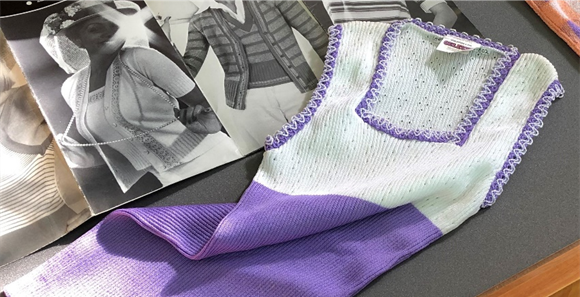Over the coming weeks we’ll be sharing the experiences of some of our volunteers in a series of blogs by the team behind the Memories from Carrickfergus exhibition and film. This week’s story comes from Rachel Sayers;
Throughout 2021, I have found volunteering for the Courtaulds project at National Museums NI immensely enjoyable, as not only have I met some wonderful people through the project, I have also enhanced my knowledge of textile and fashion production in Northern Ireland. Researching, finding, and discussing our research has been incredibly exciting as we delved further into the people, place, and products that made Courtaulds Carrickfergus. Learning from one another every week during our digital meet-ups has afforded me new skills in using newspapers, advertisements, and other first-hand sources in historical research whilst also gleaming invaluable skills in team work and volunteering, albeit digitally!
A particular highlight was interviewing the oral history participants and hearing their wonderful stories and insights into their working lives at Courtaulds. One of my interviewees, June, lives in British Columbia but through the power of Zoom, we were able to record an interview with her – one of the benefits of the 2021 lockdown! June regaled me with her experiences of working at Courtaulds, particularly how she met her husband and trained to work in the accounting office.
June had an excellent time working for Courtaulds and made life-long friends, with one friend being her bridesmaid at her wedding in the early 1960s and regularly visiting one another in both Canada and Northern Ireland. The emphasis from all my interviewees was the comradery between workers, particularly the people you worked closely with, and a happy balance between work and play – especially the famous Christmas party held every year for staff and residents of Carrickfergus!
As someone who is interested in local dress and textile history, the stories of textile production from the interviewees and from our research greatly enhanced my own knowledge of textile production across Northern Ireland. I read with interest how rayon, nylon, polyester etc. produced at the Courtaulds factory at Carrickfergus was used in 1950s Dior inspired dress, 1960s Mary Quant style miniskirts, and the famous flares of the 1970s and worn by people from across the world. From local to global, Courtaulds-produced material was utilised by designers, dressmakers and shops across the world to produce high-quality products that started life in Carrickfergus.
Volunteering has been a wonderful highlight of my year, which has been difficult for many. Even though meetings have been conducted online, we have managed to collate interesting information into a wonderful booklet, film, and an online exhibition. The emphasis has always been on the place, people and product, which I feel is reflected in all our outcomes and I look forward to hearing feedback from our participants. I hope in the future to volunteer again with National Museums NI as the experience has been brilliant.
(Image of Courtaulds employees in their own wonderful fashions, courtesy of Frances O’Brien)










